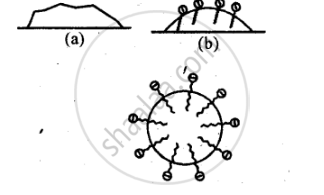Advertisements
Advertisements
Question
Action of soap is due to emulsification and micelle formation. Comment.
Solution 1
The cleansing action of soap is due to emulsification and micelle formation. Soaps are basically sodium and potassium salts of long chain fatty acids, R-COO-Na+. The end of the molecule to which the sodium is attached is polar in nature, while the alkyl-end is non-polar. Thus, a soap molecule contains a hydrophilic (polar) and a hydrophobic (non-polar) part.
When soap is added to water containing dirt, the soap molecules surround the dirt particles in such a manner that their hydrophobic parts get attached to the dirt molecule and the hydrophilic parts point away from the dirt molecule. This is known as micelle formation. Thus, we can say that the polar group dissolves in water while the non-polar group dissolves in the dirt particle. Now, as these micelles are negatively charged, they do not coalesce and a stable emulsion is formed.
Solution 2
Soap is sodium or potassium salt of a higher fatty acid and may be represented as RCOO–Na+(e.g., sodium stearate CH3(CH2 )16 COO–Na+ which is a major component of many bar soaps). When dissolved in water, it dissociates into RCOO– and Na+ ions. The RCOO– ions, however, consist of two parts – a long hydrocarbon chain R (also called non-polar ‘tail’) which is hydrophobic (water repelling), and a polar group COO– (also called polar- ionic ‘head’), which is hydrophilic (water loving).
The RCOO– ions are, therefore, present on the surface with their COO– groups in water and the hydrocarbon chains R staying away from it and remain at the surface. But at critical micelle concentration, the anions are pulled into the bulk of the solution and aggregate to form a spherical shape with their hydrocarbon chains pointing towards the centre of the sphere with COO– part remaining outward on the surface of the sphere. An aggregate thus formed is known as ‘ionic micelle’.
The cleansing action of soap is due to the fact that soap molecules form micelle around the oil droplet in such a way that hydrophobic part of the stearate ions is in the oil droplet and hydrophilic part projects out of the grease droplet like the bristles. Since the polar groups can interact with water, the oil droplet surrounded by stearate ions is now pulled in Water and removed from the dirty surface. Thus soap helps in emulsification and washing away of oils and fats. The negatively charged sheath around the globules prevents them from coming together and forming aggregates.

(a) Grease on cloth
(b) Stearate ions (from soap) arranging around the grease droplets
(c) Micelle formed
APPEARS IN
RELATED QUESTIONS
Give reasons for the following observations: Addition of alum purifies the water
What are emulsions?
What are their different types emulsions? Give one example of each type.
What are the dispersed phase and dispersion medium in milk?
How do emulsifires stabilise emulsion? Name two emulsifiers.
Give four uses of emulsions.
Give one example each of 'oil in water' and 'water in oil' emulsion.
Answer the following question.
What is the difference between an emulsion and a gel?
Give three uses of emulsions.
Match the types of colloidal systems given in Column I with the name given in Column II.
| Column I | Column II |
| (i) Solid in liquid | (a) Foam |
| (ii) Liquid in solid | (b) Sol |
| (iii) Liquid in liquid | (c) Gel |
| (iv) Gas in liquid | (d) Emulsion |
What is the role of adsorption in froth floatation process used especially for concentration of sulphide ores?
During preparation of ice-cream gelatin is added in ice-creams. What could be the role of gelatin in the process?
